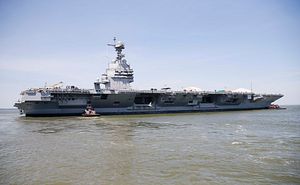The delivery of the first nuclear-powered Gerald R. Ford-class aircraft carrier USS Gerald R. Ford (CVN-78) is being delayed by about a month and a half, the U.S. Navy announced on July 12 citing “first-of-class” problems, military.com reports.
U.S. Navy spokeswoman Captain Thurraya Kent said that “during the ongoing testing of developmental systems onboard the CVN-78, first-of-class issues are continuing to be resolved.” According to Thurraya, the estimated new delivery date is November 16, but additional delays may occur. “If additional issues arise during the remaining shipboard testing, that date may need to be revised,” she said.
Thurraya offered no details what components are causing the delay. In the past, there were some problems with the Advanced Arresting Gear (AAG) on the flight deck. In September 2015 the U.S. Navy announced that it had identified “a slight deterioration in the required progress on the CVN-78 shipboard test program.” This pushed back the delivery date by eight weeks.
The USS Gerald R. Ford was slated to undergo seas trials this August, but it is unclear whether the schedule will be kept. In June, the new aircraft carrier completed it turn ship evolution. It was the first time that the ship has moved from its pier since leaving a dry dock in November 2013. “The turning of the ship signals the race to the end,” said Newport News Shipbuilding construction supervisor Shayne Laws.
“Turning the ship is an opportunity for the crew to demonstrate for the first time all the procedures required to get the ship underway safely,” said Commanding Officer Captain Richard McCormack. “Our new pier position will allow the ship and shipyard team to complete the remaining pierside testing required before our upcoming sea trials.”
Ship-construction is 98 percent complete. One of the major issues remains cost overruns. According to the Congressional Research Service:
CVN-78 was procured in FY2008. The Navy’s proposed FY2017 budget estimates the ship’s procurement cost at $12,887.0 million (i.e., about $12.9 billion) in then-year dollars. The ship received advance procurement funding in FY2001-FY2007 and was fully funded in FY2008- FY2011 using congressionally authorized four-year incremental funding. To help cover cost growth on the ship, the ship received an additional $1,374.9 million in FY2014-FY2016 in FY2015 in so-called cost-to-complete procurement funding.
One of the fiercest critics of the Gerald R. Ford-class aircraft carrier program has been Senate Armed Services Committee chairman John McCain. In a July 12 statement published by USNI News, McCain said that the aircraft carrier will be delivered with many systems unproven:
The Navy’s announcement of another two-month delay in the delivery of CVN-78 further demonstrates that key systems still have not demonstrated expected performance. The advanced arresting gear (AAG) cannot recover airplanes. Advanced weapons elevators cannot lift munitions. The dual-band radar cannot integrate two radar bands. Even if everything goes according to the Navy’s plan, CVN-78 will be delivered with multiple systems unproven.
Furthermore, he added:
The Ford-class program is a case study in why our acquisition system must be reformed – unrealistic business cases, poor cost estimates, new systems rushed to production, concurrent design and construction, and problems testing systems to demonstrate promised capability. After more than $2.3 billion in cost overruns have increased its cost to nearly $13 billion, the taxpayers deserve to know when CVN-78 will actually be delivered, how much developmental risk remains in the program, if cost overruns will continue, and who is being held accountable.
Next to the first-of-class USS Gerald R. Ford (CVN-78), three more ships (CVN-79, CVN-80, and CVN-81) have been announced. In total, the new Gerald R. Ford-class aircraft carrier fleet will consist of ten vessels.































